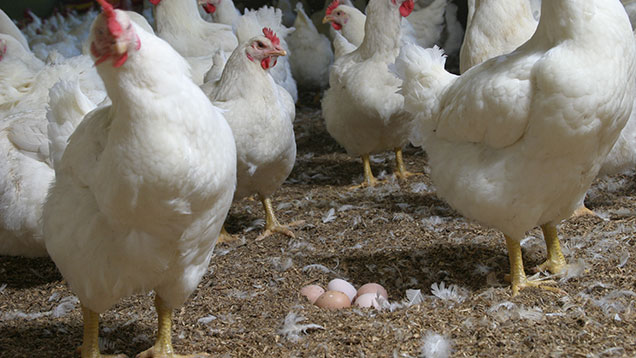How to avoid floor eggs in breeding flocks

Minimising floor eggs takes careful management and swift reactions, as Paul Welten, a technical manager with Cobb Europe, explains.
The success of a breeder flock depends on producing good-quality hatching eggs with high hatchability, delivering first-quality broiler chicks.
And that means minimising floor eggs, which have an average 10% lower hatchability and produce poorer-quality chicks due contamination from the dirty environment. Flocks achieving less than 1% floor eggs are normal, but a flock with more than 5% is deemed a problem requiring investigation and corrective action.
Rearing period
The conditions in which the birds are reared and trained have a big impact. The following steps should be taken:
- Birds should be given early access to perches, to encourage them to use nest boxes later. They should be installed by four weeks of age, one perch for every 500 birds.
- Avoid electric wires on feed or drinking lines. The birds become nervous and afraid to jump on slats in the production house.
- Rear the pullets according to the breed’s bodyweight profiles. Overweight birds are more prone to lay floor eggs.
- Reduce the light intensity in the rearing period, to allow at least a sevenfold increase in intensity in the production house.
Production period
Floor eggs are highest at the start of production and it is essential that they are removed as soon as possible to prevent more eggs being laid in the same place.
Once the hens have laid more than four eggs in a certain location, they will continue to lay there and, post-peak production, it is very difficult to reduce the number of floor eggs.
Management tips
- Move the pullets to the production house at least two weeks before they start laying so they can adapt to their environment.
- Open the nests when the first egg is laid. Don’t open them too quickly because the females will lose their interest and it becomes a resting place, which they will make dirty.
- Nipple lines should have a water flow of 80-100cu cl/minute so the birds satisfy their water needs quickly and do not block the nest entrance area.
- Male and female development should be synchronised. Active males push the females up on the slat area, however overactive males can lead to hen damage and mortality.
- Enough nest space is crucial; birds don’t want to wait. The requirement for an automatic nest is a minimum 100sq cm nest space for one bird (1sq m for 100 birds).
- Control bodyweight so the birds don’t get overweight and too fleshed.
- Avoid too much bedding in the scratch area – 2-3cm is enough.
- Diseases, red mites and leg problems increase the number of floor eggs.
Nest management
More and more companies are changing from individual nest boxes to community nests because of labour savings. Both types can work well.
The nest should have easy access and it should be an attractive place to lay an egg. The construction material should be bird friendly and provide environmental comfort to the hen. It is essential that there are no draughts because this will discourage birds from using it.
Manual type nest
Cobb suggests a maximum four-and-a-half birds a nest, depending on type. The walking distance to the nest should be less than 10m, and the vertical depth should be at least 15cm. Enough litter should be provided to a maximum of two-thirds full.
A slat area should be provided before entry to the nest, with a maximum distance from the floor to the top of the slat of 40‐45cm.
Egg collection should be carried out regularly to prevent more than three eggs in any nest; any more will increase the risk of broken eggs and pre-incubation.
Automatic nests
Birds like to lay their eggs in the dark, so a curtain covering the entrance is important. To attract the birds to the nest, a slat area of 40‐50% of the total floor area with a slope of 7‐10% is suggested.
Place one feeder line and one drinker line on the slat about 60cm apart, with the drinker line about 70cm from the nest opening. Never place all the feeder lines on the slat because this will discourage birds from going to the litter area and will reduce male and female interaction.
Open the nests before the lights switch on and close them one hour before the lights switch off.
Lighting
Light distribution should be uniform and prevent any shadows that would encourage the hen to lay on the floor. Light intensity should be at least 60 lux at floor level, and avoid high light intensity at the nest entrance.
Feeding
Place the feeder high enough to allow the birds to move freely across the floor area, at least 20cm from the litter and, if possible, winch up the system after feeding. Start with feeding 30 minutes after lights switch on, or when 80% of the eggs are laid.
